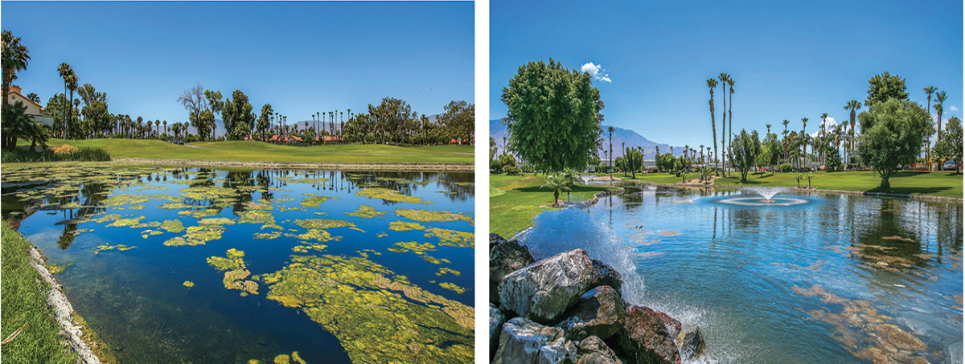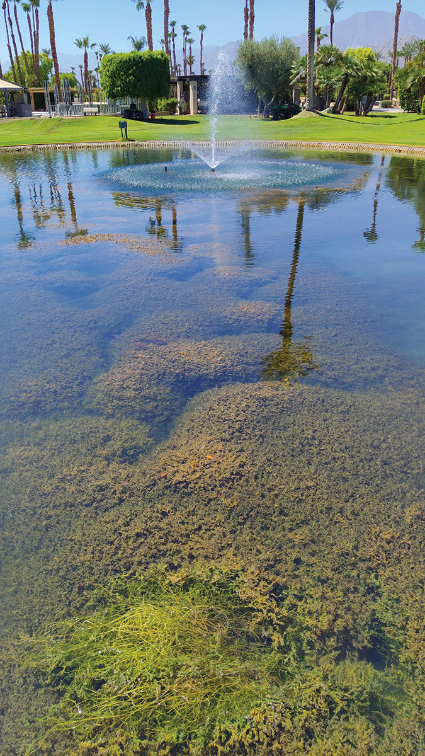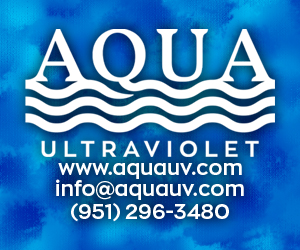Maintaining a decorative waterscape is a byword for eternal vigilance. When it comes to caring for streams, ponds and lakes, it is as though each individual water feature has its own distinct personality. Some are easygoing and never seem to require anything more than simple preventive measures, while others are a real challenge, more resembling bratty children that can never be satisfied than straightforward inanimate bodies of water.

Despite this fact, the good news is that every “bratty” problem has a solution. However, be cautioned that the right solution done the wrong way is likely to create greater troubles than the one you began with. Water features are sensitive ecosystems teeming with life. In the world of aquatic management, mistakes can be costly and deadly. The use of blue-chip aquatic professionals really can’t be understated.
So, now let’s focus on the big three most common problems and bare-bones solutions to keep your water clean, clear and biologically healthy.
Surface Slime
No matter how crystal clear the surface of the water may appear, assemblages of microorganisms such as bacteria, archaea and fungi are naturally building on the water’s surface. They attract and concentrate nutrients and have the capacity to detect and move toward any high concentrations of nutrients — an ability called chemotaxis. They are one part of the recipe for the eventual growth of biofilm, slime, sludge or algae (different and dissimilar photosynthetic organisms).

In fact, they’re not actually invisible, but they can’t necessarily be seen by the naked eye. The recipe starts to take shape when unchecked phosphates, nitrogen and other organic materials are allowed to proliferate in the water. They provide nutrition, contributing to the spread and growth of this unsightly stew, until the point that they have gone from invisible to the naked eye to an eyesore. The best approach to this problem is vigilant intervention, which requires understanding of how the cycle is fueled.
Basically, there are four main contributing factors to water features becoming fertile grounds for algae growth. The first is runoff from overwatering the adjacent fertilized turf. Nutrients in the fertilizer energize growth, thus lighting the algae powder keg. Next, trees in close proximity to the water are inevitably going to bestrew the water with leaves and other debris from the tree. (Again, this is another major source of nutrients.) Third, dumping grass clippings into the water or allowing grass-clipping piles to blow into the water is the quickest way to throw off the water’s pH balance. Grass clippings contain high levels of nitrogen and phosphorus, which are going to quickly stimulate the growth of slime. Finally, reclaimed water might be great for the environment, but it’s not so great for water features. The nutrient load and high salt content of reclaimed water leads to color, odor and, of course, algae problems. This is an issue you cannot likely avoid — but be aware of it.
In many respects, this is all nature running amok in uncontrolled water features. Since the problem is the combination of organisms in the water building up on the surface and the uncurbed introduction of nutrients, the smartest approach is addressing each part of the recipe individually. As with all aquatic management, begin with ecosystem balance. Ensure that there is adequate circulation, manageable nutrient levels (there will always be some), proper aeration and use of equipment and approved chemicals to control contaminants.
The most common ways of restoring balance include introducing products that help slow down the rate of biological contamination; thoroughly cleaning filters and replacing all filter media; running the water feature’s filter around the clock (if possible, but no less than twelve hours a day) to ensure containments are being filtered out and oxygenation to the water is ample for healthier water; and blocking sunlight and turning off any light sources that contribute to the growth of undesirable organisms.
However, if you’re already looking at algae, sludge, slime — whatever you want to call it — then it needs to be eradicated as soon as possible. It will not likely die of its own accord. In this case, apply a product to kill and control the algae. Remember not to overdo it or use a product that is essentially aquatic napalm! Unless the blooms are so out of the control that all you can see for miles is slimy green stuff, use a gentle but efficient product. Follow it with products that will slow the regrowth of algae.
Pond Foam
Foam isn’t the worst thing in the world, but it’s certainly not pretty. Generally speaking, foam occurs when there is an excess of proteins in the water. The additional proteins come from dissolved organic material, including fish food. As with slime, natural forces are running amok. The proteins in the water are a biological process. However, when they are not breaking down fast enough, they manifest into foam.
Before adding defoamer, be sure there is adequate filtration and aeration. Also, make sure any fish stock is in proportion to the size of the water feature. Too many fish will create more waste than a water feature, and the filtration system is designed to accommodate. Once those boxes are checked, using a defoamer is a smart and safe chemical ingredient to add to the water and resolve the immediate ugly mess.
Clouded Over

A loss of water clarity invariably means there is a chemical imbalance in the water or turbidity, which is defined as the cloudiness or haziness of a fluid caused by individual particles (suspended solids) that are generally invisible to the naked eye — similar to smoke in air.
Flocculants, clarifiers and other chemical additives attach like magnets to contaminants, with the resulting heavier particles falling to the bottom or getting clumped together. This helps them more efficiently run through the filter and become trapped in the media.
However, this is a short-term fix. In the long term, like always, you’ll want to ensure that the filtration and aeration are at their peak. This should bring clarity to the water. In addition, adding certain bacteria will enhance the water quality and clarity and be helpful in the digestion of sludge at the bottom of any water feature.
So, these are the bare-bones solutions for the big three problems almost all water features face. Maintaining a decorative waterscape is a byword for eternal vigilance. These beautiful features are designed to be aesthetically pleasing. Unfortunately, when they get out of balance, they can suddenly have the opposite effect, looking sick (and kind of ugly).
Once again, there is no single, simple and easy solution. Water features can be a real headache. The best advice I can give is to call in the experts. It’ll save time. Usually, when you save time, you save money.
Either way, you’ll certainly save any potential embarrassment!


